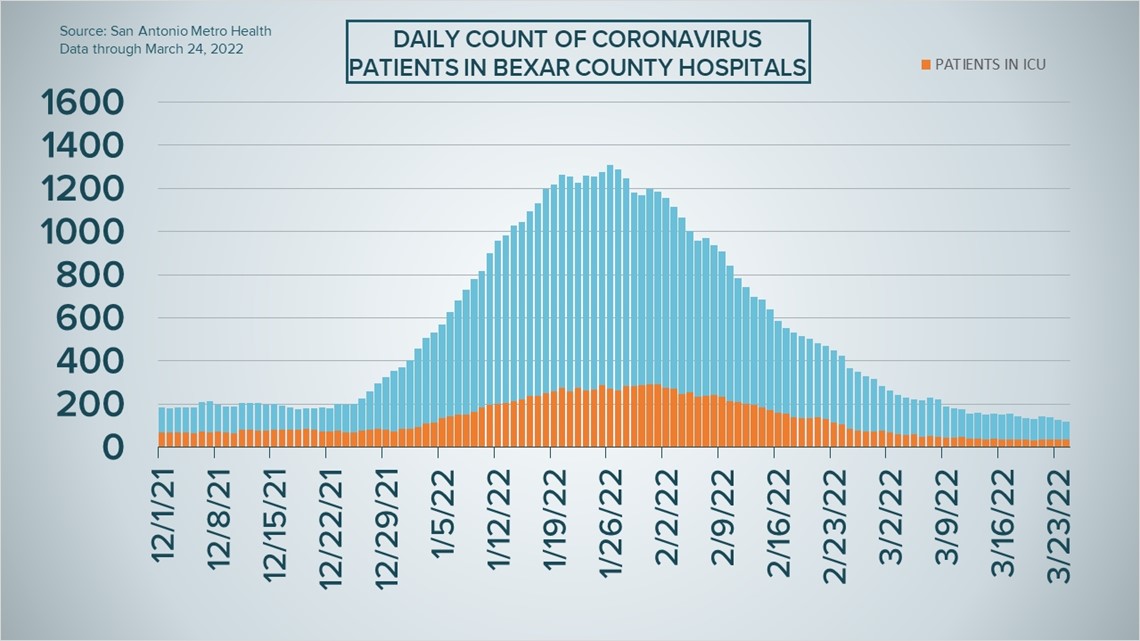SAN ANTONIO — Hospital stress in Bexar County remained moderate and the COVID-19 risk level "low" on Thursday as local health authorities reported just 81 new cases, along with one additional death from virus complications.
March has yielded an average of 97 new coronavirus cases a day, compared to 935 in February and nearly 4,800 in January, when the community and country was in the grip of the highly contagious omicron variant. Regardless, Metro Health leaders continue to promote booster shots; just 35% of Bexar County's vaccine-eligible population has received one as of Monday.
There was no change from the seven-day case average on Thursday, remaining at 60.
Meanwhile, local COVID-19 hospitalizations are down to their lowest levels since June 19 of last summer. There were 119 patients receiving treatment for their symptoms on Thursday; of those, 37 were in intensive care and 16 were on ventilators.
Nearly 531,000 Bexar County residents have been diagnosed with COVID-19 over the course of the pandemic, while at least 5,307 have died from virus complications.
How Bexar County is trending




Vaccine Progress in Bexar County
The following numbers are provided by San Antonio Metro Health. A full breakdown can be found here.
- 1.432 million eligible Bexar County residents are fully vaccinated as of Monday, March 14
- More than 490,000 eligible Bexar County residents have received their COVID-19 booster shot, as of Monday, March 14.
The CDC states that "when a high percentage of the community is immune to a disease (through vaccination and/or prior illness)," that community will have reached herd immunity, "making the spread of this disease from person to person unlikely."
The City of San Antonio breaks down the vaccination rates by zip code on Metro Health's Vaccination Statistics page.
Coronavirus in Texas
The total number of coronavirus cases in the state since the pandemic began grew by 2,768 on Thursday, according to the Texas Department of State Health Services. That total includes 969 new confirmed cases and 1,799 new probable cases. More details can be found on this page.
Thursday's figures bring the total number of Texans diagnosed with COVID-19 to more than 6.645 million.
An additional 61 Texans have died from virus complications, meanwhile, raising the statewide death toll to 85,702.
Coronavirus symptoms
The symptoms of coronavirus can be similar to the flu or a bad cold. Symptoms include fever or chills, cough, shortness of breath or difficulty breathing, fatigue, muscle or body aches, headache, new loss of taste or smell sore throat, congestion or runny nose, nausea or vomiting, and diarrhea, according to the Centers for Disease Control.
Most healthy people will have mild symptoms. A study of more than 72,000 patients by the Centers for Disease Control in China showed 80 percent of the cases there were mild.
But infections can cause pneumonia, severe acute respiratory syndrome, kidney failure, and even death, according to the World Health Organization. Older people with underlying health conditions are most at risk.
Experts determined there was consistent evidence these conditions increase a person's risk, regardless of age:
- Chronic kidney disease
- COPD (chronic obstructive pulmonary disease)
- Obesity (BMI of 30 or higher)
- Immunocompromised state (weakened immune system) from solid organ transplant
- Serious heart conditions, such as heart failure, coronary artery disease, or cardiomyopathies
- Sickle cell disease
- Type 2 diabetes
- The CDC believes symptoms may appear anywhere from two to 14 days after being exposed.
Human coronaviruses are usually spread...
- Between people who are in close contact with one another (within about 6 feet).
- Through respiratory droplets produced when an infected person coughs, sneezes or talks. These droplets can land in the mouths or noses of people who are nearby or possibly be inhaled into the lungs.
- Some recent studies have suggested that COVID-19 may be spread by people who are not showing symptoms.
Help stop the spread of coronavirus
- Stay home when you are sick.
- Eat and sleep separately from your family members
- Use different utensils and dishes
- Cover your cough or sneeze with your arm, not your hand.
- If you use a tissue, throw it in the trash.
Find a Testing Location
City officials recommend getting a COVID-19 test if you experience fever or chills, cough, shortness of breath or difficulty breathing, fatigue, muscle or body aches, headache, new loss of taste or smell, sore throat, congestion or runny nose, nausea or vomiting, or diarrhea.
Here's a Testing Sites Locator to help you find the testing location closest to you in San Antonio.
Latest Coronavirus Headlines
- Biggest cities took heavy losses during the COVID pandemic's first year
- Local governments spent COVID relief money on hotel, ballpark, ski slopes
- Moderna update could mean COVID vaccines for youngest children by summer
- New COVID variant rapidly spreading overseas detected in Bexar County
- Hillary Clinton tests positive for COVID-19
- From 'This is not over' to 'I'm not losing sleep': Experts vary on COVID-19 BA.2 variant concern
- SAISD removes mask mandate starting Tuesday
- Federal vaccine ad features San Antonio native with long COVID-19

